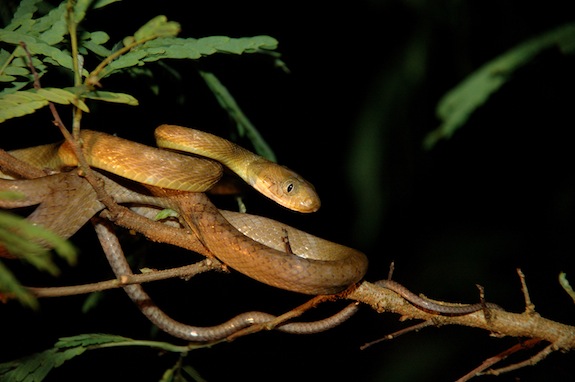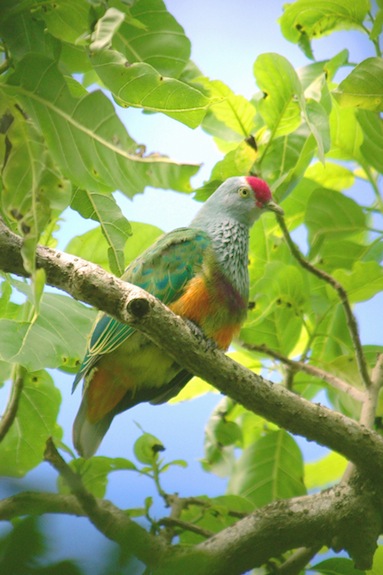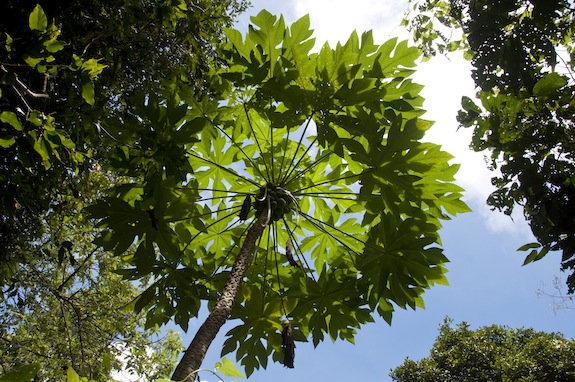Where Have the Trees of Guam Gone?
Scientists are investigating whether the obliteration of the island’s bird species is thinning the tree canopy and could alter the forests’ structure
Scientists believe the absence of seed-dispersing birds is thinning the forests on the island of Guam. Photo by Isaac Chellman
Visitors to Guam’s forests find them quiet–eerily so: No chirping of birds can be heard overhead. But slithering in the shadows on the ground are snakes, each some six feet long. Brown tree snakes made their debut on Guam, the southernmost island in the Mariana Archipelago, when islanders were rebuilding after World War II. Most likely, they were stowaways in lumber shipments heading north through the Pacific Ocean from New Guinea. They quickly began feasting on the birds and small lizards they discovered in Guam’s dense forests, and–free to slither through the mountainous terrain without predators of their own–they completed an invasion of the island at a pace of one mile per year. By the late 1940s, the forests had largely fallen silent, and now, all of Guam’s native bird species are history.
Last fall, scientists from Rice University and the University of Guam published one of the first studies of the island’s extinct forest birds, which include species such as the Mariana fruit dove, Guam flycatcher and Rufous fantail. They focused on how the absence of birds has caused a spike in the spider population, which is 40 times greater on Guam than nearby islands.
Now, the researchers are turning their attention to the issue of Guam’s thinning forests—a consequence, they also believe, of the bird deficit. This summer they’ll launch a four-year study of 16 tree species, looking at how the loss of birds, which scatter seeds, is affecting tree distribution.

The brown tree snake has obliterated nearly all of Guam’s bird species since it was introduced during World War II. Photo by Isaac Chellman
The study has its roots in an a-ha moment that lead scientist Haldre Rogers recently had while conducting another seed-dispersal study in Guam’s forests. “I noticed that there seemed to be a lot of gaps and that the pioneer tree species–such as papaya and sumak–were difficult to find on Guam, compared to nearby islands,” she explained to Surprising Science. She discovered that there were in fact twice as many such gaps on Guam per unit area of forest.
Pioneer trees, which are the first to appear after a disruption to the ecosystem and thrive in the full sunlight of open spaces in the forest, have small seeds that are consumed by small birds. “Without birds to move their seeds to these sunny spots in the forest, these quick-growing trees may be less likely to germinate or grow to their full size,” Rogers hypothesized.
The problem with such thinning is that it could change the structure of Guam’s forests. “There’s a concern that may become filled with open areas and start to look more like Swiss cheese than a closed canopy forest,” Rogers said. In other words, what were once cool, dark forests could transform into hot, open sunny ones.
There are other possible explanations for the tree-thinning: An undiscovered forest disease could be targeting pioneer species, or mammals like pigs and deer might have a strong taste for the trees. But according to Rogers, there isn’t strong evidence to support either of these scenarios. The upcoming study will attempt to determine the cause definitively.

The Mariana fruit dove was driven to extinction by the brown tree snake on Guam and is highly endangered on other islands in the Mariana Archipelago. Photo by Isaac Chellman
To that end, the researchers will cut down individual trees in various spots within Guam’s forests, creating new gaps in the forest. They’ll also remove trees from locations on two nearby islands that are still brimming with birds. Then they’ll monitor how long it takes the spaces to fill in and take note of which seedlings thrive on Guam versus on the other islands. It may seem that to get their results they’re destroying what they’re trying to study, but in actuality they’re taking down a tiny percentage of the island’s trees–20 total.
Guam’s situation is similar to that of tropical regions worldwide. “Animals involved in seed-dispersal are in decline in a lot of tropical forests around the world right now,” the co-principal investigator of the study, Amy Dunham, said in a statement. “It’s very important to understand the implications of those declines.” So far scientists have looked into the role of endangered mammals like lemurs, giant tortoises (PDF) and African forest elephants (PDF) in seed dispersal, but the upcoming study will be one of the first to focus on endangered birds.
It’s also the rare study to examine what happens when seed dispersal completely ceases–Guam being the only place in the world to experience whole-island forest bird loss in modern times. “The situation on Guam–which is tragic–provides us with a unique opportunity to see what happens when all seed-dispersal services provided by animals are lost from an entire ecosystem,” Dunham said.
The snakes, meanwhile, continue to dominate the island of Guam. The U.S. Department of Agriculture traps approximately 6,000 brown tree snakes each year, and yet there are still nearly two million slithering around the island. The snakiest patches contain 14,000 of the reptiles per square mile–one of the highest snake concentrations in the world.
In February, the Department of Agriculture embarked on a new tactic for tackling the snake problem: dropping dead mice laced with acetaminophen, which is fatal to them, into the jungle. ”We are taking this to a new phase,” Daniel Vice of the Department of Agriculture’s branch that focuses on wildlife services in Hawaii, Guam and other U.S. held Pacific Islands, said in a recent interview. “There really is no other place in the world with a snake problem like Guam.”
